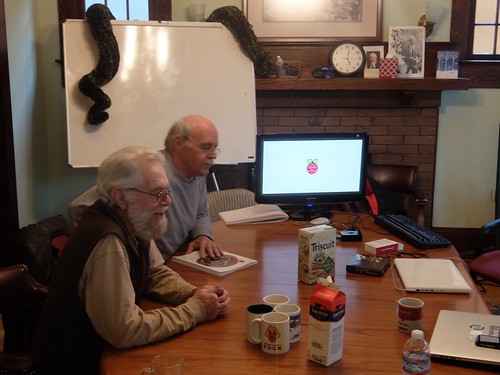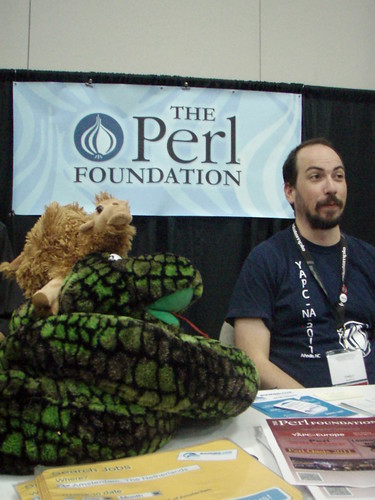I enjoyed a great turnout for this Raspbian presentation, an induction into the subculture of Raspberry Pi for some of us. My focus was the ARM chip itself, billions served, and I kicked it off recounting my first stumbling upon the Acorn system, in Paro, Bhutan (Druk-yul). Some Brits had set up shop there, and were not running DOS or Windows.
The ARM chip was inspired by UC Berkeley + Stanford writings on a RISC architecture, which remained pie-in-the-sky insofar as Intel x86 was concerned, the Pentium and so on offering rich vocabulary chips.
The ARM, in contrast, stayed more comprehensible in some scenarios, and lower power, so made its way, post Acorn, into Samsung and other devices, running applications (A), as well as more real time (R) and embedded (M) devices. The ARM network of partners rivals (and partially overlaps) Intel's.
So from Advanced RISC Machine to these three "architecture profiles", ARM has preserved mnemonic value, good branding. Raspberry Pi is its own brand and Barbara Stross, bless her good sense, brought raspberries and yogurt, the better to celebrate with. The Pi is likewise a "Py machine", playing well with Python.
I brought the museum-worthy Python Software Foundation's retired mascot to the event. Mascots are not so much in fashion these days and this stuffed toy had no role in the latest Pycon, here in Portland. Maybe I'll lug her (Naga), to the next one, and bequeath her back to some booth. I ended up with her thanks to Steve Holden, former PSF chairman, and quick to ride the wave of mascots being cool, when they were.
Below, you'll see said Python snake cuddling with the Perl camel. This went along with my quip that the Dutch windmill in the Republic of Perl background was "Guido's house", so close was Python to Perl, even if with some different philosophies (ours more zen).
Some Silicon Forest heavy hitters came out of the woodwork for this one and educated me on various matters, including Measure 98, as distinct from Measure 97. They make sense as a duo. I passed Peter Farrell's Hacking Math Class around, as suggestive of what Math + Pi, vs. Math + TI, might look like. I also screened my Habitat for Humanity talk during the break, in part just to show off how the Pi 3 can stream Youtubes, no problemo.
After the meetup we checked out the new campus mural, gradually materializing to our immediate west. The Far West becomes the Far East in that puzzle Christopher Columbus never quite figured out. He was more interested in gold than worldly wisdom, is what the pundits say. I digress.
Yes, to some extent I made Texas Instruments the bogey-man in my story, but not the good engineers who'd invented the microchip. Of course the scientific calculator is a miracle to behold. I understand how we might get somewhat cultish about it (I was, about the HPs).
TI is also in on the ARM action I'm finding, so it's not like we have to play either / or here. Oregon's high schoolers might get more bash shell soon (the Linux dashboard / API) as technology permeates STEM and/or STEAM (A for Anthropology, part of PATH). I'm not against showcasing Intel's Edison within #CodeCastle (a space of keepers). Stay tuned.
The ARM chip was inspired by UC Berkeley + Stanford writings on a RISC architecture, which remained pie-in-the-sky insofar as Intel x86 was concerned, the Pentium and so on offering rich vocabulary chips.
The ARM, in contrast, stayed more comprehensible in some scenarios, and lower power, so made its way, post Acorn, into Samsung and other devices, running applications (A), as well as more real time (R) and embedded (M) devices. The ARM network of partners rivals (and partially overlaps) Intel's.
So from Advanced RISC Machine to these three "architecture profiles", ARM has preserved mnemonic value, good branding. Raspberry Pi is its own brand and Barbara Stross, bless her good sense, brought raspberries and yogurt, the better to celebrate with. The Pi is likewise a "Py machine", playing well with Python.
I brought the museum-worthy Python Software Foundation's retired mascot to the event. Mascots are not so much in fashion these days and this stuffed toy had no role in the latest Pycon, here in Portland. Maybe I'll lug her (Naga), to the next one, and bequeath her back to some booth. I ended up with her thanks to Steve Holden, former PSF chairman, and quick to ride the wave of mascots being cool, when they were.
Below, you'll see said Python snake cuddling with the Perl camel. This went along with my quip that the Dutch windmill in the Republic of Perl background was "Guido's house", so close was Python to Perl, even if with some different philosophies (ours more zen).
Some Silicon Forest heavy hitters came out of the woodwork for this one and educated me on various matters, including Measure 98, as distinct from Measure 97. They make sense as a duo. I passed Peter Farrell's Hacking Math Class around, as suggestive of what Math + Pi, vs. Math + TI, might look like. I also screened my Habitat for Humanity talk during the break, in part just to show off how the Pi 3 can stream Youtubes, no problemo.
After the meetup we checked out the new campus mural, gradually materializing to our immediate west. The Far West becomes the Far East in that puzzle Christopher Columbus never quite figured out. He was more interested in gold than worldly wisdom, is what the pundits say. I digress.
Yes, to some extent I made Texas Instruments the bogey-man in my story, but not the good engineers who'd invented the microchip. Of course the scientific calculator is a miracle to behold. I understand how we might get somewhat cultish about it (I was, about the HPs).
TI is also in on the ARM action I'm finding, so it's not like we have to play either / or here. Oregon's high schoolers might get more bash shell soon (the Linux dashboard / API) as technology permeates STEM and/or STEAM (A for Anthropology, part of PATH). I'm not against showcasing Intel's Edison within #CodeCastle (a space of keepers). Stay tuned.


